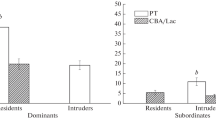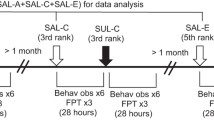Abstract
In order to test the usefulness of motivational hypothesis in the analysis of drug action on rat social behaviour, the frequency with which rats select the section of the cage in which there are other rats was evaluated in control sessions and after drug administration.
In the given experimental conditions, the decoy rats become a sufficient stimulus for the acquisition of a discriminating conditioned reflex.
Chlorpromazine (2 mg/kg) was without effect, but pentobarbital (3 mg/kg) abolished the power of the decoy rats to influence the behaviour of other rats.
For the interpretation of these results it is not necessary to postulate social motivations but it is sufficient to attribute to the decoy rats the properties of a conditioned stimulus.
Similar content being viewed by others
References
Bayroff, A. G.: Direction orientation and the forward-going tendency in white rats. J. comp. Psychol. 15, 211–218 (1933).
Brown, B. B.: CNS drugs actions and interaction in mice. Arch. int. Pharmacodyn. 128, 391–414 (1960).
Brown, H., Richards, R. K.: An interaction between drug effects and food reinforced “social” behaviour in pigeons. Arch. int. Pharmacodyn. 164, 286–293 (1966).
Chance, M. R. A., Silverman, A. P.: The structure of social behaviour and drug action. CIBA Symposium, Animal Behaviour and Drug Action, pp. 65–79. Eds. H. Steinberg, A. V. S. de Reuck and H. Knight. London: Churchill 1964.
Dews, P. B.: Studies on behaviour. I. Differential sensitivity to pentobarbital of pecking performance in pigeons depending on the schedule of reward. J. Pharmacol. exp. Ther. 113, 393–401 (1955).
Grant, E. C.: Analysis of the social behaviour of the male laboratory rat. Behaviour 21, 260–281 (1963).
Molinengo, L.: Azione di alcuni psicofarmaci sul ratto condizionato sec. Skinner con un doppio programma simultaneo. Arch. ital. Sci. farmacol. 26, 373–375 (1961).
Molinengo, L.: Modificazioni procovate da alcuni depressori del SNC nel ratto valutate per mezzo della inivizione operativa. Arch. ital. Sci. farmacol. 28, 224–227 (1963).
Molinengo, L.: Azione di alcuni depressivi del SNC sulla coordinazione motoria del ratto. Arch. ital. Sci. farmacol. 29, 288–291 (1964).
Molinengo, L.: Profilo psicofarmacologico degli ipnotici. Atti della Iℴ Riunione della Soc. It. Neuropsicofarmacologia, pp. 139–195 (1967).
Molinengo, L., Ricci-Gamalero, S.: Behavioural action and tranquillizing effect of reserpine, diazepam and hydroxyzine. Arch. int. Pharmacodyn. 180, 217–231 (1969).
Molinengo, L., Ricci-Gamalero, S.: The “staircase maze” and the “simple staircase” in the analysis of the psychopharmacological action of CNS depressants. Pharmacology 4, 169–178 (1970).
Moss, F. A.: Study of animal drives. J. exp. Psychol. 7, 165–185 (1924).
Omwake, L.: The influence of barbital on the activity and learning of white rats. J. comp. Psychol. 16, 317–325 (1933).
Ray, O. S.: Tranquillizer effects as a function of experimental anxiety procedures. Amer. Psychologist 17, 398 (1962).
Ray, O. S.: Tranquillizer effects as a function of experimental anxiety procedures. Arch. int. Pharmacodyn. 153, 49–68 (1965).
Rosenzweig, M. R., Kreech, D., Bennett, E. L.: Effects of pentobarbital sodium on adaptive behaviour petterns in the rat. Science 123, 371–372 (1956).
Silverman, A. P.: Ethological and statistical analysis of drug effects on the social behaviour of laboratory rats. Brit. J. Pharmacol. 24, 579–590 (1965).
Skinner, N. F.: Two “synthetic social relations”. J. exp. Anal. Behav. 5, 531–533 (1962).
Tsai, C.: The relative strength of sex and hunger motives in the albino rat. J. comp. Psychol. 5, 407–416 (1925).
Williams, G., O'Brien, C.: The effect of sodium phenobarbital on the learning behaviour of white rats. J. comp. Psychol. 23, 457–474 (1937).
Author information
Authors and Affiliations
Rights and permissions
About this article
Cite this article
Molinengo, L. Social behaviour of albino rats: A methodological and pharmacological approach. Psychopharmacologia 28, 235–242 (1973). https://doi.org/10.1007/BF00429303
Received:
Revised:
Issue Date:
DOI: https://doi.org/10.1007/BF00429303




